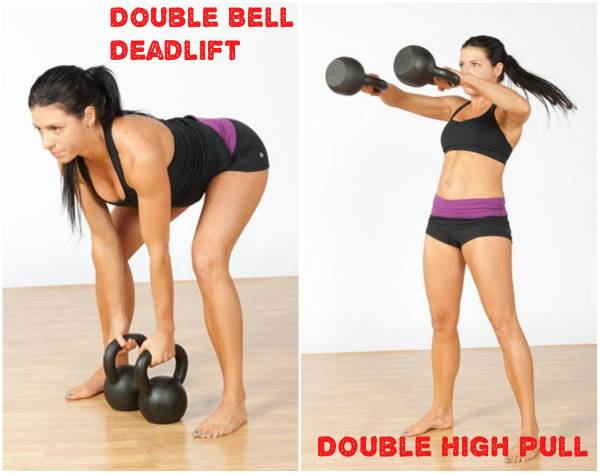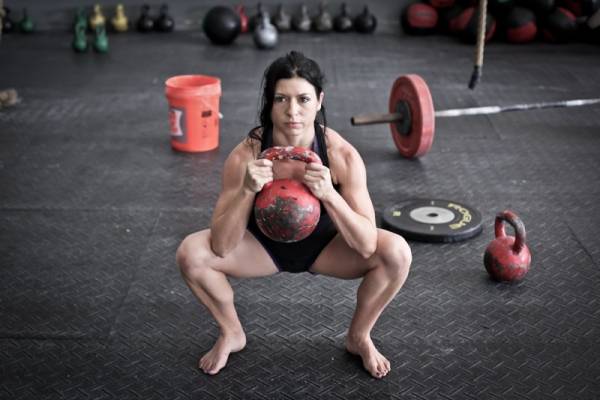Designing your own workouts can be quite a challenge. Even the most experienced exerciser who has a clear understanding of how to properly execute a variety of exercises can struggle with laying out a simple, effective program.
Designing your own workouts can be quite a challenge. Even the most experienced exerciser who has a clear understanding of how to properly execute a variety of exercises can struggle with laying out a simple, effective program.
Over the years I have worked with many clients, including fitness professionals, who unfortunately design poor programs that cause them to become frustrated with their lack of results and even create imbalances and injuries. As much as it’s exciting to constantly have fancy and fun exercises, keeping it simple and balanced is what will deliver the most results.
The Right and Wrong About Kettlebell Workouts
Below are three workouts an experienced kettlebell user can do on his or her own. This program is for individuals who have continued goals of moving better as well as increasing overall strength and conditioning. This, of course, will also have the great side effects of fat loss and a lean body.
The first workout is a balanced combination of both strength and conditioning. Workout two is focused mostly on conditioning. And the third is focused mostly on strength. Most of the workouts that I design for my classes fall between workout one and three. But sometimes it’s nice to have a day here and there of just light, fun conditioning.
Each of these workouts has something in common. They all contain skill-work practice and a balance of exercises that require a push, pull, leg, and full body. Keeping those aspects involved in the majority of your practice sessions will decrease the chances of developing major imbalances and weaknesses in some areas, with too much strength in others.
For example, you don’t want to have too many workouts that focus on high-rep push ups and presses. You will ruin your shoulders and back. Not adding in the farmer’s walks, pull ups, rows, and horizontal rowing will get you in trouble, too. Each exercise is there for a reason.

Unfortunately, there are many programs out there that people have no business doing. The other day I saw an instructor post this on their blog as the workout of the day for their class. This was an instructor with reputable certifications including one in kettlebells. If you wonder why you are losing clients due to injuries you may want to rethink how you structure your program.
Warning: Do NOT perform this workout. This is just a sample of what NOT to do!
Rules: Complete the suggested amount of reps for each exercise as fast as you possibly can. Then get as many Turkish Get Ups as you can in 5 minutes.
50 Push-ups
50 Presses
50 Burpees
50 Crunches
50 Swings
Finish with 5 minutes of Turkish Get Ups
If you did workouts like this several times a week, you’d be injured and imbalanced very quickly. If you cannot understand why doing five minutes of Turkish get ups at the end of a high volume workout is unsafe contact me and I’ll explain it to you.
3 SAFE KETTLEBELL WORKOUTS
Here are the three safe workouts to rotate and play with on your own. I have also provided three sample weeks of how to schedule these workouts, as well as videos of the first two for you to follow along.
Workout 1: Full Body Focus Strength and Conditioning
Choose a size kettlebell that ensures you can perform each exercise with perfect form, yet is challenging. If you find the rep range suggested is too easy, then use a heavier kettlebell next time. Do not go to failure. Focus on working 75-80% of your maximal efforts with this workout.
A1. Turkish Get Up, 2 per side
A2. 1 Arm Swing, 10 per side
Rest for a few seconds and repeat 2-3 times
B1. Push up, 5-8 reps
B2. Goblet squat, 5-6 reps
B3. One-arm row, 5-6 reps per side or pull ups, 4-6 reps
B4. Snatch, 10 per side
Rest for a few seconds and repeat 2-3 times
Workout 2: Conditioning Focus
Pick a kettlebell that feels easy so you can maintain perfect form. Set your timer or Gymboss for 15 seconds. You will spend 30 seconds on each exercise. Some of the exercises will require you to do 15 seconds per side. Take a full 30 second rest in between each exercise.
A1. Push press, 15 sec per side
A2. Two-hand swing, 30 sec
A3. Jump squats, 30 sec
A4. High pulls, 15 sec per side
Rest 30-60 seconds and repeat for 2-3 rounds
B1. One-arm swings or snatch, 15 sec per side
B2. Burpees (push up optional), 30 seconds
B3. Double farmer’s walk, 30 seconds
Rest 30-60 seconds and repeat for 2-3 rounds
Workout 3: Strength Focus
Generally when focusing on strength, you still want to approach the workout as practice. Therefore, using a heavy enough bell that allows you to have perfect reps should be your goal. I didn’t do a video for this one – I’m going to trust you to handle this on your own!
A1. Single-leg deadlift (double bells), 5 each side
A2. Clean and press, 3-5 per side
A3. Renegade rows, 5 per side
A4. Double swings, 8 reps
Take roughly a 20-60 second rest in between each exercise so you can feel fresh before beginning the next exercise. Repeat this section for 3-5 rounds.
B1. Pull ups or one-arm row, 3-5
B2. Single-leg box squats, 3-5 per side
B3. Double cleans, 8 reps
Take roughly 20-60 second rest in between each exercise so you can feel fresh before beginning the next exercise. Repeat this section for 3-5 rounds.

How to Plan Your Workouts for The Week
Below are sample weeks of how to use these workouts effectively. Choose the type of volume you know your body can handle. If you participate in sports or other exercise such as running, then the lower volume week would be my suggestion. If you are trying to pack on extra muscle, gradually work up to 5 sets instead of the suggested 2-3 sets. Perform joint mobility daily, if possible.
Sample 1: Less Volume Training Week
- Monday: Workout 1: Full Body Focus Strength and Conditioning
- Tuesday: Active Recovery i.e. Restorative Yoga or/and Joint Mobility
- Wednesday: Workout 2: Conditioning Focus
- Thursday: Active Recovery i.e. Restorative Yoga or/and Joint Mobility
- Friday: Workout 3: Strength Focus
- Saturday: Active Recovery i.e. Restorative Yoga or/and Joint Mobility
- Sunday: Walking, Hill Sprints, or Turkish Get Up Practice
Sample 2: Higher Volume Training Week
- Monday: Workout 1: Full Body Focus Strength and Conditioning
- Tuesday: Workout 2: Conditioning Focus
- Wednesday: Active Recovery i.e. Restorative Yoga or/and Joint Mobility
- Thursday: Workout 3: Strength Focus
- Friday: Workout 1: Full Body Focus Strength and Conditioning
- Saturday: Active Recovery i.e. Restorative Yoga or/and Joint Mobility
- Sunday: Workout 3: Strength Focus
Sample 3: Integrating Strength and Conditioning With Your Activity
- Monday: Sports Practice (i.e. running, tennis, surfing)
- Tuesday: Workout 1: Full Body Focus Strength and Conditioning
- Wednesday: Sports Practice (i.e. running, tennis, surfing)
- Thursday: Short Sports Practice or Rest
- Friday: Workout 2: Conditioning Focus
- Saturday: Workout 3: Strength Focus + Sports Practice (i.e. running, tennis, surfing)
- Sunday: Active Recovery i.e. Restorative Yoga or/and Joint Mobility (or easy practice)
Hope you enjoy these workouts. Try them out for four to six weeks and let me know how you do. Keep a journal and record your workouts. Most of all listen to your body. Post any questions to the comments below.






